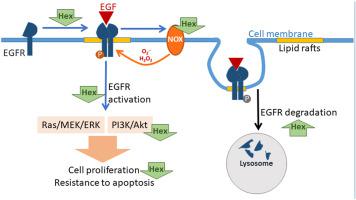Redox Biology ( IF 10.7 ) Pub Date : 2020-12-10 , DOI: 10.1016/j.redox.2020.101830 Elena Daveri 1 , Ana M Adamo 2 , Eugenia Alfine 3 , Wei Zhu 3 , Patricia I Oteiza 3

|
Dietary proanthocyanidins (PAC) consumption is associated with a decreased risk for colorectal cancer (CRC). Dysregulation of the epidermal growth factor (EGF) receptor (EGFR) signaling pathway is frequent in human cancers, including CRC. We previously showed that hexameric PAC (Hex) exert anti-proliferative and pro-apoptotic actions in human CRC cells. This work investigated if Hex could exert anti-CRC effects through its capacity to regulate the EGFR pathway. In proliferating Caco-2 cells, Hex acted attenuating EGF-induced EGFR dimerization and NADPH oxidase-dependent phosphorylation at Tyr 1068, decreasing EGFR location at lipid rafts, and inhibiting the downstream activation of pro-proliferative and anti-apoptotic pathways, i.e. Raf/MEK/ERK1/2 and PI3K/Akt. Hex also promoted EGFR internalization both in the absence and presence of EGF. While Hex decreased EGFR phosphorylation at Tyr 1068, it increased EGFR Tyr 1045 phosphorylation. The latter provides a docking site for the ubiquitin ligase c-Cbl and promotes EGFR degradation by lysosomes. Importantly, Hex acted synergistically with the EGFR-targeted chemotherapeutic drug Erlotinib, both in their capacity to decrease EGFR phosphorylation and inhibit cell growth. Thus, dietary PAC could exert anti-CRC actions by modulating, through both redox- and non-redox-regulated mechanisms, the EGFR pro-oncogenic signaling pathway. Additionally, Hex could also potentiate the actions of EGFR-targeted drugs.
中文翻译:

六聚原花青素通过表皮生长因子信号通路的氧化还原和非氧化还原调节抑制结直肠癌细胞生长
膳食原花青素 (PAC) 摄入量与结直肠癌 (CRC) 风险降低相关。表皮生长因子 (EGF) 受体 (EGFR) 信号通路的失调在人类癌症(包括结直肠癌)中很常见。我们之前表明,六聚 PAC (Hex) 在人类 CRC 细胞中发挥抗增殖和促凋亡作用。这项工作调查了 Hex 是否可以通过其调节 EGFR 通路的能力发挥抗 CRC 作用。在增殖的 Caco-2 细胞中,Hex 可以减弱 EGF 诱导的 EGFR 二聚化和 Tyr 1068 处 NADPH 氧化酶依赖性磷酸化,减少 EGFR 在脂筏上的位置,并抑制促增殖和抗凋亡途径的下游激活,即 Raf/ MEK/ERK1/2 和 PI3K/Akt。在存在和不存在 EGF 的情况下,Hex 还能促进 EGFR 内化。虽然 Hex 降低了 EGFR Tyr 1068 的磷酸化,但它增加了 EGFR Tyr 1045 的磷酸化。后者为泛素连接酶 c-Cbl 提供对接位点并促进溶酶体降解 EGFR。重要的是,Hex 与 EGFR 靶向化疗药物厄洛替尼具有协同作用,两者都能降低 EGFR 磷酸化并抑制细胞生长。因此,膳食 PAC 可以通过氧化还原和非氧化还原调节机制调节 EGFR 促癌信号通路来发挥抗 CRC 作用。此外,Hex 还可以增强 EGFR 靶向药物的作用。











































 京公网安备 11010802027423号
京公网安备 11010802027423号